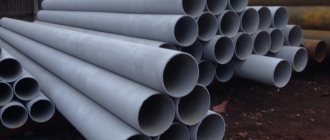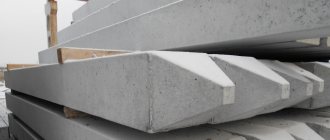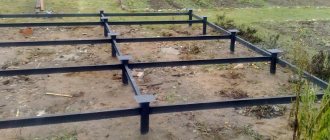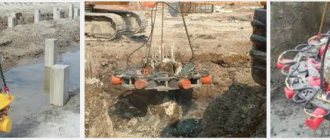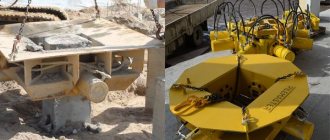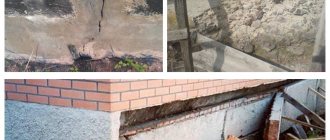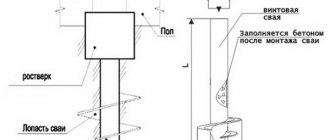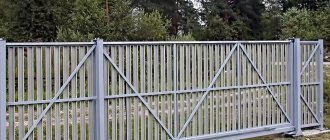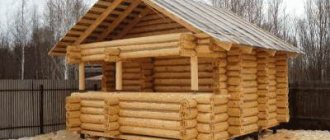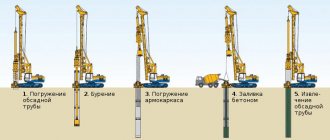Installing a screw foundation is a decision that is made by the developer based on accurate calculations and logical justifications. There is still a lot of work ahead, and the most important thing that should be taken care of first is to avoid mistakes when arranging the foundation for future construction. The cost of installing a pile and the desire to carry out the basic processes of building a house yourself force you to set serious goals for yourself.
Correctly installing a screw foundation means observing all the specified parameters: horizontal and vertical levels, distances between piles, permissible deviations from linear dimensions, etc. And if the problem of ensuring a horizontal level is solved by trimming or building up, then how to ensure compliance with the specified distances, we will talk in this article.
Installing a pile-screw foundation with your own hands is a labor-intensive task. It requires error-free calculations, the presence of special devices and the participation of at least two people - the cost of an error here can be too high.
How to tighten screw piles when building a foundation
Screw support elements are immersed in the ground using the method of gradual screwing, which is combined with indentation.
Structural parts of the pile:
- A barrel that has a guide section with helical blades and an extension. The latter also has blade parts, but more often it consists of couplings and a barrel.
- Load-bearing screw blades.
- A pointed pile tip (cast) with load-bearing screw wings.
When screwed in, the screw elements pass through different soil layers and shift slightly due to the unevenness of the soil. Screwing involves a slight installation inaccuracy compared to driving or injection. There are solid particles in the ground, such as large roots or rock inclusions, so sometimes the screw post becomes stuck.
Stopper means a situation where 3 - 5 people twisting the pile element cannot deepen it any longer. The rod reaches a dense layer that cannot pass through, so screwing is stopped. If the immersion depth is insufficient, the pile is removed and screwed next to the marking line. It is not recommended to screw into the same passage.
The emphasis on a strong layer means that the pile has reached a stable layer of soil, its bearing capacity will correspond to the design value.
What you can use, tools and equipment
A mechanical pile driver grabs the shaft, holds it and slowly twists the wings of the tip into the soil at a specified angle. More often, vertical rods are placed at an angle of 90°, and the inclination (up to 45°) is taken according to calculation and additionally indicated in the drawing.
The equipment consists of working parts:
- basic platform for installing units on wheels or tracks;
- retractable hydromechanical jacks (4 pcs.) for fixing the machine and adjusting the stop;
- hydraulic grip;
- drive for twisting the pile and coordinating the angle of inclination;
- control panel.
The rotational force is transmitted through the drive to the tip of the vertical post, the blades begin to rotate. The rod is plunged into the ground by turning the screws and overcomes the soil obstacle. The integrity of the tip at this stage of deepening is important, so the pointed structural element is made of a durable alloy and cast.
There is a danger of destruction or deformation of the welded blade wings when they hit stones, but hydraulics overcome the resistance. Screwing does not destroy the soil layers, but compacts the soil around the trunk to a distance of 1 - 2.0 meters, depending on the cross-section of the vertical element.
Installation of pile foundations
If the soil density is uniform throughout the entire site, then no problems with driving the piles will occur. Of course, it can often happen that when the machine is twisting, stones and roots can get under the blades of the products, which will cause the structure to break or deviate from the given vertical. That is why the choice of piles must be taken very seriously. Before installing the piles, you need to tackle the foundation project, in which you need to take into account all the nuances:
- Soil type after geological surveys
- House size. Load. Material for construction
- Number of piles
- Pole placement diagram
- Pile tying
- Pile pipe diameter
It is worth saying that the diameter of the pipe is especially important, because the stability of the product and the bearing capacity of the foundation as a whole will depend on it.
How to tighten piles using a motor drill
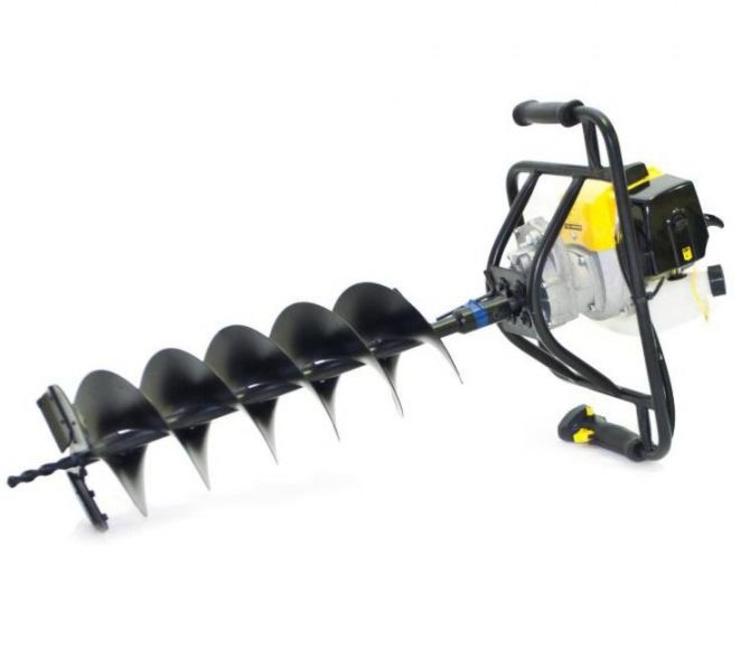
Motor drill
Carry out marking and preparation of the surface of the site before diving. A motor drill allows you to install the screw stand strictly vertically, but the work takes place with the participation of two people. I choose the diameter of the drill auger so that it is smaller than the cross-section of the pile in order to obtain an effective grip and avoid distortion.
The first elements are installed in the corners of the foundation, and the achievement of a stable soil layer is noted. The racks at the corners are immersed at the design mark, and the intermediate elements can be buried less if the rack does not go any further, and additional supports can be added along the marking line.
Features of working with a motor drill:
- rocky and stony soils are drilled at low speeds, trying to lift large elements;
- when the vibrating auger jams, use the reverse (reverse) stroke;
- the worker takes a stable position so that the jerk during the stop does not knock him down;
- the drill is removed and cleaned from the ground every half hour of work;
- rocky layers are passed with the installation of carbide blades on the auger.
The motor drill effectively copes with any type of soil, while paying attention to the structural characteristics of the pile rods. The diameter, pitch of the blades, and angle of inclination are selected individually and depend on the load and physical properties of the soil layer.
Types of motor drills and installation process
A motor drill is selected depending on the category of soil; the device for driving screw piles is classified according to the type of motor and power.
Mechanical lightweight units weigh 11 kg, and one person can do the job. The units differ in motor power up to 3.5 l/s. The manual unit is used only for drilling in soils of categories 1 and 2 with low densities.
An automatic device with an increased engine capacity of up to 7 l/s requires a second worker to operate it when drilling dense rocks. The unit weighs 30 kg, so 1 operator can work on light soils. Such units are also used in gentle conditions.
Two-block motor drills include a motor and a drilling section, which are located on the connecting rod. The power is 5 - 8 l/s, and the weight of the unit is 80 kg. The connecting rod absorbs recoil when there is high soil resistance, so one worker can handle it. Precise equipment maintains verticality without deviation.
Motorized drills based on hydraulics have a power of 11 - 15 l/s, they are used for lands of groups 2 and 3. Manual installations are easy to move around a construction site; one worker can drill, but it all depends on the strength of the soil. More often, domestic Iron installations are used, which the manufacturer supplies with a mechanical drive and hydraulics.
Advantages of the manual method
Screw piles are a modern, economical foundation option for relatively small and lightweight buildings. Installation of supporting elements can be carried out on any soil, even weak ones, at any time of the year. Installation of piles is carried out manually and mechanically.
The manual method is applicable in situations where the use of special equipment is undesirable or unavailable for one reason or another. Main examples: a populated area with existing buildings, difficulties with the passage of equipment, the presence of communications and plantings that cannot be disturbed. It is also more expedient to install screw piles manually when the area of the object is small, when a small number of supporting elements are required.
Drilling screw piles with a hole drill
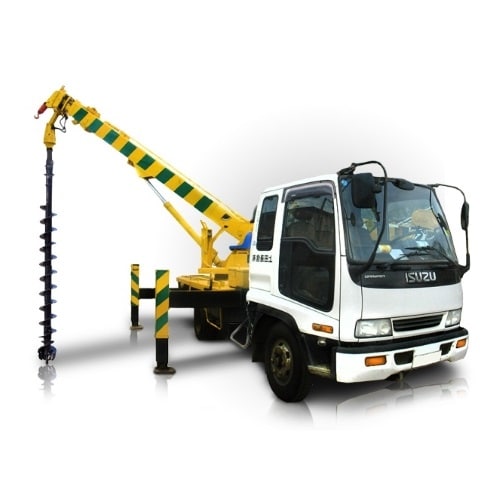
Yamobur
A pit drill is a device for screwing piles, which is used if you need to screw in a lot of screw posts in a short period of time. During a shift, the team makes 30 piles using this unit.
The work consists of the following stages:
- placing a hydraulic rotator in the pile shaft and fixing it with a pin;
- alignment and installation of the vertical rod at the installation point;
- screwing the post into the ground.
The drill works without problems in difficult and cramped conditions. The obstacle in the form of coarse rocks does not stop the action of the drill, nor does the installation of supports in reservoirs or on waterlogged coastal slopes. The hole drill allows you to install screw elements at different times of the year and does not depend on the weather. Reliably screws piles with permissible errors in accordance with regulatory documents.
The unit is used in summer cottages and courtyards due to its small dimensions.
Pit drills are produced on the basis of a gasoline or electric motor. The kit includes a set of tips for different categories of soil and drilling at an angle. To make the tip, they use durable metal with a special coating to increase its service life.
Winter installation features
Winter installation of screw support pile structures is practically no different from their installation in the summer season. Installation of screw piles in winter is carried out taking into account some features:
- A large amount of snow on a construction site makes it impossible to see the uneven topography of the soil.
- Drilling is more difficult in frozen ground.
- The concrete mixture for filling voids must have frost-resistant additives.
- The metal surface of pile structures at low temperatures requires careful handling due to the risk of burns.
These factors increase the complexity of winter installation of screw structures. If the building site is located in a swampy or flooded area, then it is impossible to install a pile-screw foundation in the summer, but in winter it will be possible to move freely on frozen soil and construction and installation work can begin.
Since the pile is made of metal, its fragility increases in severe frosts, so during installation there is no need to use sharp impacts and vibration forces.
Features of screwing screw piles with a meat grinder
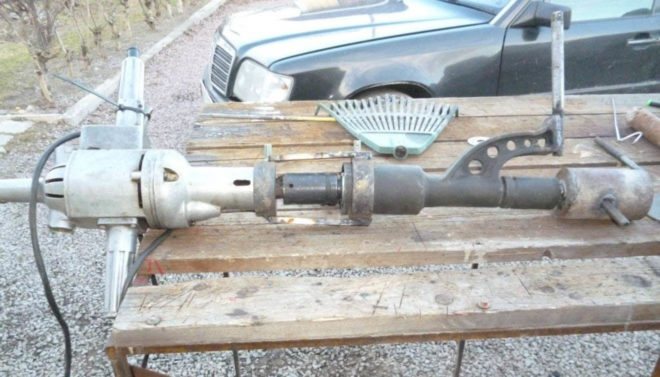
Meat grinder
A meat grinder is a manual device that includes an electric or hydraulic transmission mounted on a pile head. A lever pattern is used to secure the tool and transmit torque. The device takes its name from the TMK (torque amplifier) of the wheelbarrow truck, which is called a meat grinder.
A drill of normal power (2 kW) is used as a drive; drilling is organized using a mobile electricity generator. The drill must be reversible, allowing reverse turns. Instead, you can use a hydraulic motor, but the first option is more economical; a motor drill, if available, will also come in handy.
The gearbox increases the turning moment at the head of the rod and reduces the number of revolutions. The regulator must maintain a torque of at least 4500 Nm, with a gear ratio of 1:60. The torsion amplifier is preferred on bearings, and the lubricant is changed after tightening a batch of two dozen screw racks. Purchase 1 more pile for trial screwing.
What needs to be done before starting to build a house on a pile foundation
Before erecting a foundation on piles, it is necessary to carry out a series of preparatory work in order to avoid possible negative consequences in the future. First, you need to perform an analysis of the soil on which the construction of a building or structure is planned. It is better to entrust this process to a special company that has extensive experience in this field. The specialists of this company will check the aggressiveness of the soil, as well as the level of groundwater. Thanks to this, they will be able to calculate the service life of the foundations and determine the bearing capacity of the piles. Without this, you should not start construction.
It is also necessary to pay special attention to the piles themselves, because not all of them are the same. You only need to buy piles with the accompanying documentation, which must indicate all the conditions necessary for their use. In order for the foundation to last as long as possible, preference should be given to piles with an anti-corrosion coating. This is especially true in cases where construction is planned in conditions of too hard or wet soils.
What is a pile-screw foundation and its scope
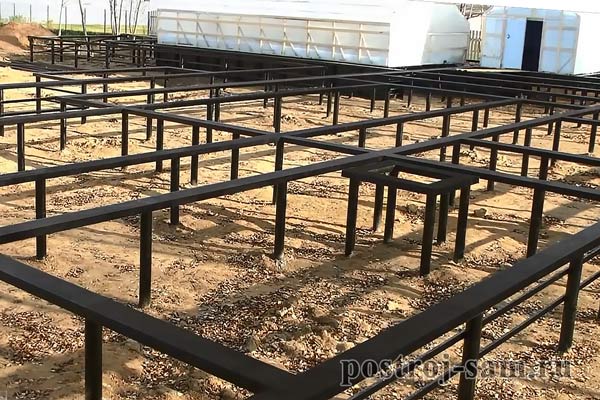
On top of the piles there is a so-called grillage, which is the tying of all separately standing screw piles into a single structure. The grillage of a pile-screw foundation is usually made of wood or metal.
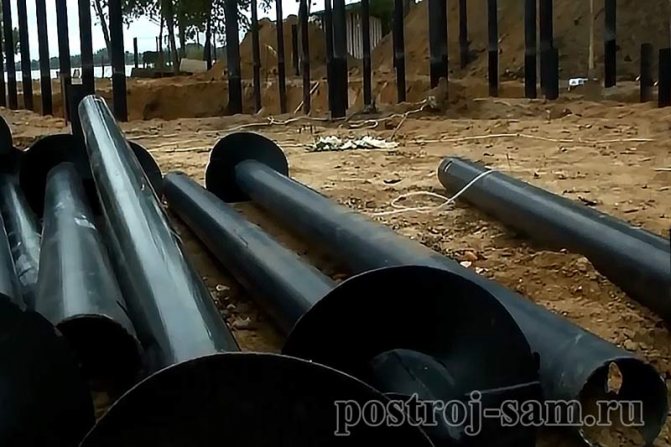
If we consider one individual pile, it is made in the form of a thick-walled metal pipe, usually with a metal thickness of 0.4 cm to 1.2 cm, at the end of which there is a blade in the form of a large thread, which helps to screw the pile into the ground. This tip will at the same time support the pile on the ground.
For ease of installation, the most common piles on sale are from 25 cm to 2.5 m long.
Previously, I wrote about the pros and cons of a pile-screw foundation for a private house, or other buildings on your site, where all the advantages and disadvantages of this type were discussed in detail. There you can learn about some of the features of this type of foundation.
We will consider the remaining characteristics and nuances of the pile-screw foundation further.
Scope of application of screw piles
In principle, the scope of application of a pile-screw foundation is quite wide, although you have probably already heard many times that such a foundation is only suitable for light wooden buildings, made of timber, for example, or frame ones.
But today, manufacturers make screw piles for almost any need, which can withstand enormous loads and are suitable for brick or block houses.
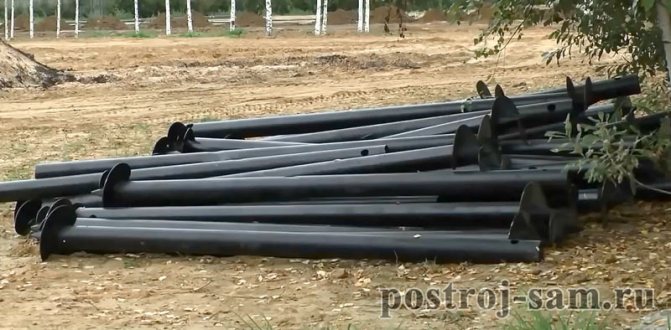
But it is worth noting that the larger the pile, the more expensive it will cost, and the installation of such piles will have to be carried out using special equipment. And in addition to this, when constructing heavy houses, the piles need to be strengthened, additionally fastened together, and this is an extra cost that can negate the most important quality of a pile-screw foundation - low cost.

Screw-pile foundations also work well in swampy areas where the water table is high and harder soil is located deep in the ground. In this case, other foundations will either be very expensive or simply not suitable for reliable support of a private house. In such soil, screw piles are a kind of salvation for those who do not have to choose a site.

